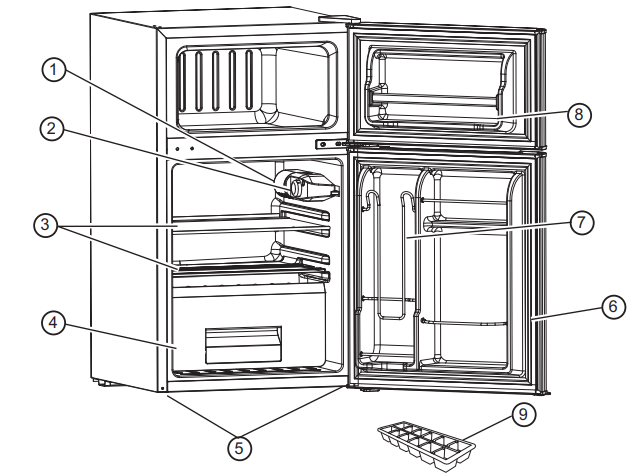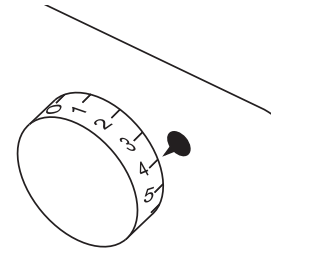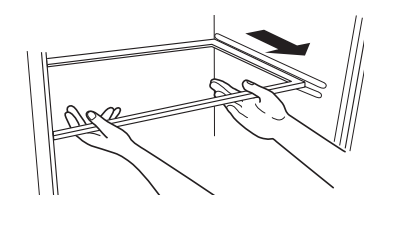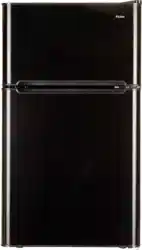Documents: Go to download!
User Manual
- User Manual - (English, Spanish)
- Energy Guide - (English)
- PARTS AND FEATURES
- REFRIGERATOR USE
- REFRIGERATOR CARE
- TROUBLESHOOTING
Table of contents
Owners' Guide Refrigeration
PARTS AND FEATURES

- Interior Light
- Temperature Control
- Refrigerator Shelves
- Crisper
- Front Leveling Legs
- Refrigerator Door Shelves
- “Dispense-A-Can™” Storage
- Freezer Door Shelf
- Ice Cube Tray
REFRIGERATOR USE
CONTROL
The control, located at the top right of the interior cabinet, is an adjustable dial with settings ranging from Least Cold (1) to Coldest (7), and 0 (OFF).
NOTE: Turning the control knob to 0 (OFF) does not disconnect the refrigerator from the power supply.
- Turn the temperature control dial to 4 (Recommended Setting).
- Allow the refrigerator to cool for several hours before adding food.

Adjusting Temperature
The recommended setting (4) is designed to maintain the temperature under normal operating conditions.
To Adjust the Refrigerator Temperature:
- Adjust the control dial to one of the adjacent settings 2 (less cold) or 5 (colder).
NOTE: Except when starting the refrigerator, do not adjust the control more than one setting at a time. - Wait 24 hours between adjustments for the temperature to stabilize.
SHELVES
To Remove or Replace a Shelf:
- To Remove - Tilt the front of the shelf upward, and then slowly slide it forward.
- To Replace - Align the shelf with the supports and gently slide the shelf toward the rear.

DISPENSE-A-CAN ™
Your refrigerator is equipped with the convenient “Dispense-A-Can™” compartment. Each compartment will hold up to six cans. Simply load the cans from the top. To dispense a can, simply draw one out from the bottom. It is that easy

CRISPER
Your refrigerator has a clear crisper. Grasp the top of the crisper and gently slide our. Push back to replace.
ICE CUBE TRAY
- If ice cube tray freezes to the bottom of the compartment, pour a little warm water around it to loosen it.
NOTE: Do not use boiling water, which can damage plastic parts, or sharp metal objects such as a knife or screwdriver, which can damage the cooling system tubing. - Wash the ice cube tray in lukewarm water only. Do not wash in the dishwasher.
REFRIGERATOR CARE
CLEANING
WARNING
Explosion Hazard
Use nonflammable cleaner.
Failure to do so can result in death, explosion or fire.
IMPORTANT: Do not use harsh chemicals, ammonia, chlorine bleach, concentrated detergent, solvents, abrasives or metal scouring pads to clean your product inside or out. They can damage and/or discolor the finish.
WARNING
Electrical Shock Hazard
Unplug your appliance or disconnect power before cleaning.
Failure to do so can result in death, electric shock or personal injury.
General
- Unplug or disconnect power.
- Wash interior surfaces, accessories, and outer frame with a solution of warm water mixed with 3 - 4 tablespoons of baking soda.
NOTE: Before using cleaning products, always read and follow manufacturer’s instructions and warnings to avoid personal injury or product damage. - Rinse with clean, warm water.
- Dry thoroughly with a soft cloth.
- Plug in or reconnect power
Door Gaskets
Gaskets must be kept clean and pliable to ensure a proper seal.
- Clean door gaskets every 3 months with solution of baking soda and warm water.
- Petroleum jelly applied lightly to the hinge-side gasket will keep the gasket pliable and ensure a good seal.
Light Bulb Replacement
- Switch off power to refrigerator.
- Gently pull out the clear cover
- Replace with same type light bulb rated at 15 watts.
- Push the clear cover back into place.
DEFROSTING AND DRAINING
DANGER
Explosion and Fire Hazard
Flammable refrigerant used.
Do not use mechanical devices to defrost freezer.
Do not puncture refrigerant tubing.
Failure to do so can result in death, explosion or fire.
For maximum energy efficiency, defrost freezer section whenever frost accumulates to a thickness of 1/4" or more on freezer walls. Note that frost tends to accumulate more during the summer months.
- To defrost freezer, remove food and ice cube tray from the freezer section. Turn temperature control dial to "0" position. Defrosting may take a few hours. To speed up defrost time, keep the door open and place a bowl of warm water in the freezer.
- During the defrost, the water will accumulate. Use a towel wipe off excess dripping water. Do not leave unattended.
- After defrosting, empty and wipe down the interior of the freezer. You may now reset your refrigerator to the desired temperature and return food.
VACATION AND MOVING
Vacation
If you will be away for an extended period of time and do not want to leave the appliance on while you are gone, prepare it for your absence.
- Remove all items.
- Turn the temperature control to the 0 (OFF) position.
- Unplug or disconnect power.
- Clean the interior. See “Cleaning.”
- Clean lid/door gaskets. See “Cleaning.”
- Prop doors open, so air can circulate inside.
Moving
If you are moving your refrigerator to a new home, prepare the appliance for the move.
WARNING
Explosion and Fire Hazard
Do not puncture refrigerant tubing.
Follow handling instructions carefully.
Flammable refrigerant used.
Failure to do so can result in death, explosion or fire.
IMPORTANT:
- Handle with care when moving to avoid either damaging the refrigerant tubing or increasing the risk of a leak.
- When moving the refrigerator, never tilt it more than a 45° angle. This could damage the compressor and the sealed system.
- Complete vacation preparation steps 1 through 5. See “Vacation.”
- Take out all removable parts, wrap them well, and tape them together so they don’t shift and rattle during the move.
- Tape the lid/door closed and tape the power cord to the back of the refrigerator.
REINSTALLING/USING REFRIGERATOR AGAIN
IMPORTANT: If the refrigerator has been placed in a horizontal or tilted position for any period of time, wait 30 minutes before plugging in the refrigerator to allow the refrigerant to settle.
- Clean refrigerator. See Cleaning.
- Place refrigerator in desired location and level. See Installation Instructions.
WARNING
Electrical Shock Hazard
See other models: HLPW028BXW HTWR12XCR HC32TW10SV HPND14XHT HA12TG21SB
Plug into a grounded 3 prong outlet.
Do not remove the ground prong from the power cord plug.
Do not use an adapter.
Do not use an extension cord.
Failure to do so can result in death, fire or electrical shock. - Plug into a grounded 3 prong outlet.
TROUBLESHOOTING
First try the solutions suggested here to possibly avoid the cost of a service call.
| PROBLEM | POSSIBLE CAUSE(S) | SOLUTION |
| Refrigerator does not run. | Refrigerator is unplugged. | Plug refrigerator into a grounded 3 prong outlet. |
| The circuit breaker is tripped/turned off or the fuse is blown. | Reset/Turn on circuit breaker or replace fuse | |
| The temperature control is in the 0 (OFF) position. | Turn the temperature control to a setting between 1 and 7. | |
| The compressor has cycled off. | Wait 30 to 40 minutes to see whether the compressor will start. | |
| Compressor runs too frequently | The room temperature is hot and/or humid. | This is normal to maintain constant temperature during high temperature, humid days. |
| Refrigerator door is ajar. | Close the door completely | |
| The door gasket is not sealing properly. | Clean the door gasket. See Cleaning. | |
| Frequent or prolonged door openings. | Limit door openings to maintain the internal temperature. | |
| Door is blocked open. | Rearrange or remove items that are keeping the door from closing completely. | |
| Refrigerator light does not work | Power is off | Check power supply. |
| Bulb is not inserted correctly | Tighten bulb in socket. | |
| Bulb needs to be replaced | Replace burned out bulb. | |
| Door does not close properly | Refrigerator is not level or door is not aligned. | Level refrigerator or align the door. |
| Door is blocked open | Rearrange or remove items that are keeping the door from closing completely. | |
| Food temperature is too warm | The door is opened frequently. | Limit door openings. |
| A large amount of food was recently added. | Allow time for recently added warm food to cool. | |
| The door is not sealing properly. | Clean the door gasket. See Cleaning. | |
| The control is not set to a cold enough temperature. | Adjust the temperature control to a colder setting. | |
| Food temperature is too cold | The control is set to a too cold setting. | Adjust the temperature to a less cold setting. |
| Refrigerator has an odor. | The refrigerator needs cleaning. | Clean refrigerator. See Cleaning. |
| Improperly wrapped food is giving off an odor | Wrap and seal food tightly before storing in the refrigerator. | |
| Gurgling sound | Refrigerant circulating through the cooling coils. | This sound is normal. |
| Clicking | The temperature control cycling on and off | This sound is normal. |
| Popping or cracking sound when compressor comes on | Refrigerator is not level. | Level the refrigerator. See Leveling. If the floor is uneven, you may need to place metal or wood shims underpart of the refrigerator. |
| The refrigerator is touching a wall. | Move the refrigerator away from the wall and re-level, if necessary. |
